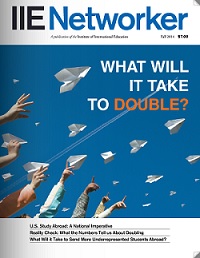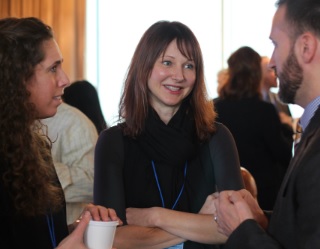Shifting the Balance of Global Brain Power

Our Corner Office spotlight shines on Daniel Obst, deputy vice president, international partnerships at the Institute of International Education. IIE is among the world’s largest international education and training organizations. IIE also has a membership program representing more than 8,000 professionals at more than 1,400 higher education institutions globally.
![]()
For personal and professional development, there’s nothing more valuable than international experience.
Studying abroad forces you out of your comfort zone, makes you think differently and really helps you get to know yourself.
There are many more foreign students at U.S. universities than there are Americans studying abroad. We need to correct that imbalance.
American students are at a huge disadvantage. Today’s employers want a global-ready workforce.
We recently caught up with frequent world traveler, Daniel Obst, just after his return from eye-opening trips to Iran and Israel. Obst provides strategic leadership and oversight for the activities of IIE’s network of 1,400 member institutions, including IIE’s publications and higher education services, its Center for International Partnerships in Higher Education, and strategic communications. He is also the editor of IIENetworker, IIE’s international education magazine, and executive editor of IIE’s Global Education Research Reports series.
Association Adviser: Daniel, what surprised you the most about Iran?
Daniel Obst: The Iranians really want to collaborate with American universities. Despite the history of U.S. sanctions, the mood is pretty optimistic. R&D [research and development] and university research is thriving. Everyone learns to speak English. Until the late 1970s, Iran was the leading sender of students to the U.S. They have a great understanding of our culture. Now China is the leading sender, but Iran is back in the top 10.
AA: Tell us a little about IIE.
DO: First of all, we’re not a trade association per se. We’re an international non-governmental organization (NGO) founded in 1919. Nearly 10,000 professionals from 1,400 higher education institutions belong. Our mission is to advance international education and access to that education. We accomplish this by managing scholarships, training, exchange and leadership programs, by conducting research and facilitating policy dialogue on global higher education and by protecting scholarship around the world.
AA: Is there such a thing as a “typical” IIE member?
DO: We serve “study abroad” directors, international student advisers, admissions directors, university presidents and other professionals who are active participants in international education exchange.
AA: We assume you have a background in higher education.
DO: I don’t. But, I have always been interested in international issues. I have a bachelor’s degree in international relations and a master’s in European studies. I came to New York City at the tail end of the dot-com bubble. My timing wasn’t great, but I worked for a startup that was building international online communities. I knew I really enjoyed that type of work. After the dot-com bubble burst, I came to IIE to help the organization build out its online forums and discussion groups.
AA: That must have been a fairly smooth transition.
DO: Actually, it wasn’t. Even though we have a lot of young people here at IIE, a not-for-profit organization is different from a dot-com. In terms of building online communities, it’s an awful lot of work that requires continuous curation [of the content]. That’s very hard to do with a small staff.
AA: So, how do you build communities?
DO: It’s a very different model. We mostly use webinars and national conference calls to discuss important issues with our members. Our webinars are free and not for NDR [non-dues-revenue] purposes. The focus is on hands-on best practices. We do one to two broad-topic webinars per month and dozens more on smaller niche topics. Typically we’ll have 50 to 100 institutions on the call, with multiple people from each institution tuning in, often from a conference room.
Our national conference calls are facilitated by an operator. They’re typically 20-minute presentations with lots of time left over for Q&A. The focus is on policy issues such as “Cooperating with Iran” or “Rules and Regulations for Cooperating with Cuba.” I know conference calls seem old fashioned, but they’re very effective for us.
AA: Can we go back to non-dues-revenue for a second?
 DO: Sure. Since our webinars are free, we sell advertising in our magazine (IIENetworker) and three of our directories (IIENetwork Handbook for International Educators, Funding for U.S. Study and Intensive English U.S.A. and half a dozen of our newsletters, which our partners at Naylor Association Solutions sell for us. Also, sponsorship has become increasingly important. With Naylor’s help we’re expanding sponsorships for our conferences — our annual Best Practices Conference in March, and two new conferences, Summit on Generation Study Abroad (October 1-2, 2015) and our 18th Annual Colloquium on International Engineering Education, later this year.
DO: Sure. Since our webinars are free, we sell advertising in our magazine (IIENetworker) and three of our directories (IIENetwork Handbook for International Educators, Funding for U.S. Study and Intensive English U.S.A. and half a dozen of our newsletters, which our partners at Naylor Association Solutions sell for us. Also, sponsorship has become increasingly important. With Naylor’s help we’re expanding sponsorships for our conferences — our annual Best Practices Conference in March, and two new conferences, Summit on Generation Study Abroad (October 1-2, 2015) and our 18th Annual Colloquium on International Engineering Education, later this year.
AA: Are there other NDR sources?
DO: Yes. Another NDR driver that’s fairly unique to our organization is sponsorship of the “Generation Study Abroad Initiative.” A country that is interested in attracting American students to study at its universities will sponsor scholarships. For instance, the government of Ireland gave us $100K so 70 students can study there.
Also, with our Center for International Partnerships in Higher Education, we have an international academic partnership program. Universities pay us a fee ranging from $9,000 to $14,000 for six to nine months of consulting-like strategy advice. Typically six to eight universities will be grouped together for a guided strategic planning process to to expand exchanges or develop institutional linkages in countries such as China, Norway, Myanmar, Cuba and more.
AA: How does that work?
To establish a scholarship or grant program, IIE works closely with the sponsor to develop guidelines, regulations, and procedures based upon international best practices. IIE designs application materials to capture relevant information from candidates as efficiently as possible. IIE also designs skill development programs to help students reach eligibility requirements.
AA: Tell us more about the “Generation Study Abroad” initiative and how you’re getting the word out.
DO: Not many people are aware, but there’s a huge “student exchange imbalance.” There are so many more foreign students who want to study here in the U.S. than there are American students who want to study overseas. Less than 10 percent of U.S. college students are studying abroad. American students are putting themselves at a huge disadvantage as today’s employers are increasingly looking for a global-ready workforce. One of our big goals is to double the numbers of American students studying abroad by 2020. We’re shooting for 600,000 students from less than 300,000 today. By comparison, there are nearly one million international students studying here in the U.S right know, especially in science and engineering.
Do we roll out a big marketing initiative? Yes and no. On the one hand, we are working to change perceptions around study abroad and will engage thousands of students in the campaign. On the other hand, this is where membership,is really key. We built a coalition of higher education partners who want to expand and invest in study abroad.
AA: We understand you’re also introducing a new conference about this topic.
DO: That’s right. Our inaugural IIE Summit on Generation Study Abroad will be held in Washington, D.C., October 1-2, 2015. It’s a way to engage our partners in IIE’s five-year initiative to mobilize resources and commitments with the goal of doubling the number of U.S. students studying abroad by the end of this decade.
AA: What are your biggest membership challenges?
DO: While we have very successful membership retention and acquisition rates, attracting international members is challenging. With so many languages and cultures, it’s very hard to do generic, one-size-fits-all marketing. You really have to customize it to each country’s native language and customs.
AA: IIE seems to be big on innovation.
DO: That’s right. Even though we’re one of the largest not-for-profits organizations in America’s biggest city, we tend to be very nimble. I guess we get some of that from my dot-com days. We start small, and see where there are opportunities and unmet needs we can fill — for instance, a pilot program for establishing an exchange program with India. If we get some traction with a small initiative, then we gradually build it out. The only way to have success is not to be afraid of failure.
I wouldn’t say we have a formal process for innovation, per se, but we do have a sizeable research team and we focus a lot on what the strategic goals of the U.S. government are. What are the government’s counties of interest? We focus on policy and opening new markets. We’re trailblazing in Iran and Cuba, for instance.
AA: How would you describe your leadership style and organizational culture?
DO: Every single person here is empowered to suggest ideas have them taken seriously. Again, that comes from my dot-com experience. Our workforce is fairly young and that kind of work environment is very important to millennials. Half of our staff has been here two years or less — they haven’t been beaten down by bureaucracy.
AA: What are some other keys to connecting with younger members of the workforce?
DO: Millennials care a lot about mission and values. In terms of connecting with them, so much more is happening through Facebook, not email. We have about 120,000 likes on Facebook. We’re also having a lot of success communicating by Instagram because we’re so visual. We recently started a Twitter channel and have about 15,000 followers (mostly B2B [business to business]). Facebook is very effective for international. Instagram seems best for U.S outreach.

AA: Any other career advice for association staffers and other not-for-profit professionals?
DO: There’s nothing more valuable on a professional and personal level than getting international experience. When you’re overseas, you must think in a completely different way. You have to get out of your comfort zone and adapt to a different culture. You really have to push yourself and really get to know yourself.


